A Novel Combined Model for Short-Term Emission Prediction of Airspace Flights Based on Machine Learning: A Case Study of China
Abstract
:1. Introduction
2. Materials and Methods
2.1. Study Area and Data Introduction
2.2. Calculation Method of Flight Emissions in Airspace
2.2.1. Aircraft Fuel Consumption Calculation Model
- (1)
- Noise reduction of original trajectory data
- (2)
- Flight key information matching
- (3)
- Judging aircraft flight phase
- (4)
- Flight airspeed conversion
- (5)
- Calculation of actual flight fuel flow rate
2.2.2. Aircraft Emissions Calculation Model
- Convert actual fuel flow rate to reference fuel flow rate
- 2.
- Calculation formula of aircraft emissions
- The cruise starting weight of each type of aircraft is the reference weight of the Operation Performance File (OPF) in the BADA database;
- The air relative humidity in the study airspace is 65.18% [22];
- The installation and deterioration effects of the aircraft engine are negligible.
- 3.
- According to the logarithmic relationship between the reference emission index and the fuel flow rate of the aircraft under reference meteorological conditions, the reference emission indexes of NOx, CO, and HC were calculated by linear interpolation, that is, the reference emission index under actual operating conditions.
- 4.
- The emission index under reference conditions was revised to the actual atmospheric conditions. Considering the influence of atmospheric effect, the calculated reference emission index was corrected to the actual atmospheric conditions, namely:where , , and , respectively, represent the emission indexes of NOx, CO, and HC under actual operating conditions, REINOx, , and , respectively, represent the emission indexes of NOx, CO, and HC under reference conditions, Hi represents the humidity correction factor under actual operating conditions, and represents the specific humidity under actual operating conditions.
2.3. Analysis of Flight Emission Data in Airspace
3. Short Term Prediction Model of Airspace Flight Emissions
3.1. LSTM Prediction Model
3.2. XGBoost Prediction Model
3.3. Combined Forecasting Model
3.3.1. Weighting Method of Combined Forecasting Model
- (1)
- RVWM
- (2)
- Adaptive time-varying weighting model (ATVWM)
3.3.2. Weighting Method of Combined Forecasting Model
- (1)
- Database: based on the BADA model performance database (weight of aircraft and performance parameters), EEDB emission database, airspace information, meteorological information (atmosphere temperature, wind speed, and direction), flight plan information, and aircraft ADS-B flight trajectory data.
- (2)
- Data processing: an aircraft fuel consumption calculation model and aircraft emission calculation model were used to calculate the time-series data set of flight emissions in the airspace.
- (3)
- Prediction model: the data set was divided according to the proportion training set:test set = 9:1, then the LSTM prediction model and XGBoost prediction model were trained and five comparative single machine learning prediction models set up, including a Random Forest model (RF), Artificial Neural Network model (ANN) and Support Vector Machine model (SVM), to confirm the rationality of selecting the LSTM and XGBoost prediction models. The training prediction model determined the super parameters. The super parameters of the LSTM and XGBoost prediction models were determined as follows:
- (4)
- Prediction results: the short-term prediction results of airspace flight emissions over 1 h, 30 min, and 15 min were calculated according to the established variable weight combination prediction model.
- (5)
- Performance analysis: the prediction performance of each prediction model was evaluated according to the performance evaluation index.
3.4. Model Prediction Performance Index
- (1)
- Root mean square error (RMSE)
- (2)
- Mean Absolute Error (MAE)
- (3)
- Coefficient of Determination (R2)
4. Experimental Results and Discussion
4.1. Model Prediction Results
4.2. Comparison of Prediction Results
4.3. Prediction Results for Different Emissions
4.4. Analysis of Factors Related to Emissions Prediction
5. Conclusions
- (1)
- The time-series information of emissions from airspace flights have good periodic characteristics, and it is feasible and effective to forecast short-term emissions.
- (2)
- In the single machine learning model, the short-term prediction ability of airspace flight emissions using the LSTM network and XGBoost models is better than the other single machine learning models, and the variable weight combination prediction model has better prediction robustness than the equal weight combination prediction model.
- (3)
- The adaptive time-varying weighting model combining LSTM network and XGBoost model considers both the time series characteristics of data, takes into account the nonlinear characteristics of data, and can correct the prediction error of a single prediction model. The prediction accuracy is generally good, and the prediction performance of the model decreases with the statistical time scale.
- (4)
- In the process of prediction, similarity information transfer occurs between different emissions, and multi-feature factors can be used to train the prediction model to improve its prediction ability.
- (5)
- This paper is a theoretical exploration of the short-term prediction of airspace flight emissions. In the future, we can comprehensively consider the traffic information parameters of airspace and parallelize the airspace data in combination with airspace big data monitoring platforms to improve the prediction accuracy and stability of the model. This is an important research direction for taking the next step in combining the time series information of emissions in multi-sector airspace to study the temporal and spatial variation of emissions in different regions and further the intelligent perception of airspace operation quality.
Author Contributions
Funding
Institutional Review Board Statement
Informed Consent Statement
Data Availability Statement
Acknowledgments
Conflicts of Interest
References
- International Air Transport Association (IATA). 20 Year Passenger Forecast 2014–2034; International Air Transport Association: Montreal, QC, Canada, 2014. [Google Scholar]
- International Civil Aviation Organization (ICAO). 2019 Environmental Report: Aviation and Environment; International Civil Aviation Organization: Montreal, QC, Canada, 2019. [Google Scholar]
- Liu, F.Z.; Li, Z.H.; Xie, H.; Yang, L.; Hu, M.H. Predicting fuel consumption reduction potentials based on 4D trajectory optimization with heterogeneous Constraints. Sustainability 2021, 13, 7043. [Google Scholar] [CrossRef]
- Wei, Z.Q.; Zhang, W.X.; Han, B. Optimization method of aircraft cruise performance parameters considering pollution emissions. Acta Aeronaut. Astronaut. Sin. 2016, 37, 3485–3493. [Google Scholar]
- Turgut, E.T.; Cavcar, M.; Usanmaz, O. Investigating actual landing and takeoff operations for time-in-mode, fuel and emissions parameters on domestic routes in Turkey. Transp. Res. Part D Transp. Environ. 2017, 53, 249–262. [Google Scholar] [CrossRef]
- Li, J.; Zhao, Z.Q.; Liu, X.G. Study an analysis of aircraft emission inventory for Beijing capital International airport. Chin. Environ. Sci. 2018, 38, 4469–4475. [Google Scholar]
- Li, N.; Zhang, H.F. Calculating aircraft pollutant emissions during taxiing at the airport. Acta Sci. Circumst. 2017, 37, 1872–1876. [Google Scholar]
- Cao, H.L.; Tang, X.H.; Miao, J.H. Calculation and analysis of nitrogen oxide emission in LTO stage of engine basedon QAR data. Acta Sci. Circumst. 2018, 38, 3900–3904. [Google Scholar]
- Yu, N.; Zhang, M.Y.; Zhang, Y.; Tian, Y.; Zeng, R.M. Aircraft cruising phase airborne pollutant emission and dispersion. Sci. Technol. Eng. 2020, 20, 28281–28285. [Google Scholar]
- Han, B.; Liu, Y.T.; Tan, H.Z.; Wang, Y.; Wei, Z.Q. Emission characterization of civil aviation aircraft during a whole flight. Acta Sci. Circumst. 2017, 37, 4492–4502. [Google Scholar]
- Gao, L. Study on the Assessment Method of Airport Environment Carrying Capacity; Nanjing University of Aeronautics and Astronautics: Nanjing, China, 2019; pp. 54–55. [Google Scholar]
- Yang, R. Analysis and Control Strategy of Airport Ground Taxiing for Energy Saving and Emission Reduction; Civil Aviation University of China: Tianjin, China, 2019; pp. 41–43. [Google Scholar]
- Yang, L.; Li, W.B.; Liu, F.Z.; Chen, Y.T.; Zhao, Z. Multi-objective optimization of continuous descending trajectory in flexible airspace. Acta Aeronaut. Astronaut. Sin. 2021, 42, 206–222. [Google Scholar]
- Chen, D.; Hu, M.H.; Han, K.; Zhang, H.H.; Yin, J.N. Short/medium-term prediction for the aviation emissions in the en-route airspace considering the fluctuation in air traffic demand. Transp. Res. Part D Transp. Environ. 2016, 48, 46–62. [Google Scholar] [CrossRef]
- Chen, D. Research on the Methods of En Route Traffic Flow Management Based on Network Traffic Demand Prediction; Nanjing University of Aeronautics and Astronautics: Nanjing, China, 2018; pp. 65–78. [Google Scholar]
- Li, C. Research on Aviation Emission Analysis and Forecasting Methods; Nanjing University of Aeronautics and Astronautics: Nanjing, China, 2020; pp. 58–67. [Google Scholar]
- Lee, S.D.; Fahey, D.W.; Forster, P.M.; Newton, P.J.; Wit, R.C.N.; Ling, L.L.; Owen, B.; Sausen, R. Aviation and global climate change in the 21st century. Atmos. Environ. 2009, 43, 3520–3537. [Google Scholar] [CrossRef] [PubMed] [Green Version]
- Wuebbles, D.; Forster, P.; Rogers, H.; Herman, R. Issues and uncertainties affecting metrics for aviation impacts on climate. Bull. Am. Meteorol. Soc. 2010, 91, 491–496. [Google Scholar] [CrossRef] [Green Version]
- Pejovic, T.; Noland, R.B.; Williams, V.; Toumi, R. Estimates of UK CO2 emissons from aviation using air traffic data. Clim. Chang. 2008, 88, 367–384. [Google Scholar] [CrossRef]
- EUROCONTROL. User Manual for the Base of Aircraft Data (BADA) Revision 3.11. 2019. Available online: https://www.eurocontrol.int/publication/user-manual-base-aircraft-data-bada-revision-31 (accessed on 20 March 2022).
- Yang, C.K. Arrival Efficiency Evaluation and Abnormal Status Analysis of Flights; Civil Aviation University of China: Tianjin, China, 2019; pp. 38–40. [Google Scholar]
- Guo, Y.J.; Ding, Y.H. Upper-air specific humidity change over China during 1958–2005. Chin. J. Atmos. Sci. 2014, 38, 1–12. [Google Scholar]
- Zhang, Y.; Yang, S.M.; Xin, D.R. Short-term Traffic Flow Forecast Based on Improved Wavelet Packet and Long Short-term Memory Combination Model. J. Transp. Syst. Eng. Inf. Technol. 2020, 20, 204–210. [Google Scholar]
- Fan, Z.Z.; Zhao, Y.; Zhou, N.; Zhao, C.; Zhang, W.Y. Integrated model for forecasting waterway traffic accidents based on the Gray-BP neural network. J. Saf. Environ. 2020, 20, 857–861. [Google Scholar]
- Xie, X.B.; Kong, L.Y. On the ways to the traffic accident prediction based on the ARIMA and XGBoost combined model. J. Saf. Environ. 2021, 21, 277–284. [Google Scholar]
- Wang, S.; Wei, L.F.; Zeng, L. A Combined Model for Photovoltaic Power Forecasting Based on GWO-SVM and Random Forest. J. Kunming Univ. Sci. Technol. 2021, 46, 1–8. [Google Scholar] [CrossRef]
- Li, L.; Zhang, Q.M.; Zhao, J.H.; Nie, Y.W. Short-Term Traffic Flow Prediction Method of Different Periods Based on Improved CNN-LSTM. J. Appl. Sci. 2021, 39, 185–198. [Google Scholar]
- Chen, Z.Y.; Liu, J.B.; Li, C.; Ji, X.H.; Li, D.P.; Huang, Y.H.; Di, F.C.; Gao, X.Y.; Xu, L.Z. Ultra Short-term Power Load Forecasting Based on Combined LSTM-XGBoost Model. Power Syst. Technol. 2020, 44, 614–620. [Google Scholar]
- Bai, S.N.; Shen, X.L. PM2.5 Prediction based on LSTM recurrent neural network. Comput. Appl. Soft. 2019, 36, 67–70, 104. [Google Scholar]
- Zhong, Y.; Shao, Y.M.; Wu, W.W.; Hu, G.X. Short-term traffic flow prediction model based on XGBoost. Sci. Technol. Eng. 2019, 19, 337–342. [Google Scholar]
- Tan, M.M. Short Term Traffic Flow Forecasting Based on Integration of LSTM Model and Grey Model; Nanjing University of Posts and Telecommunications: Nanjing, China, 2017; pp. 18–36. [Google Scholar]
- Pan, B. Application of XGBoost algorithm in hourly PM2.5 concentration prediction. IOP Conf. Ser. Earth Environ. Sci. 2018, 113, 012127. [Google Scholar] [CrossRef] [Green Version]
- Qu, J.; Chen, H.Y.; Liu, W.Z.; Li, Z.B.; Zhang, B.; Ying, Y.H. Application of Support Vector Machine Based on Improved Grid Search in Quantitative Analysis of Gas. Chin. J. Sens. Actuators 2015, 28, 774–778. [Google Scholar]

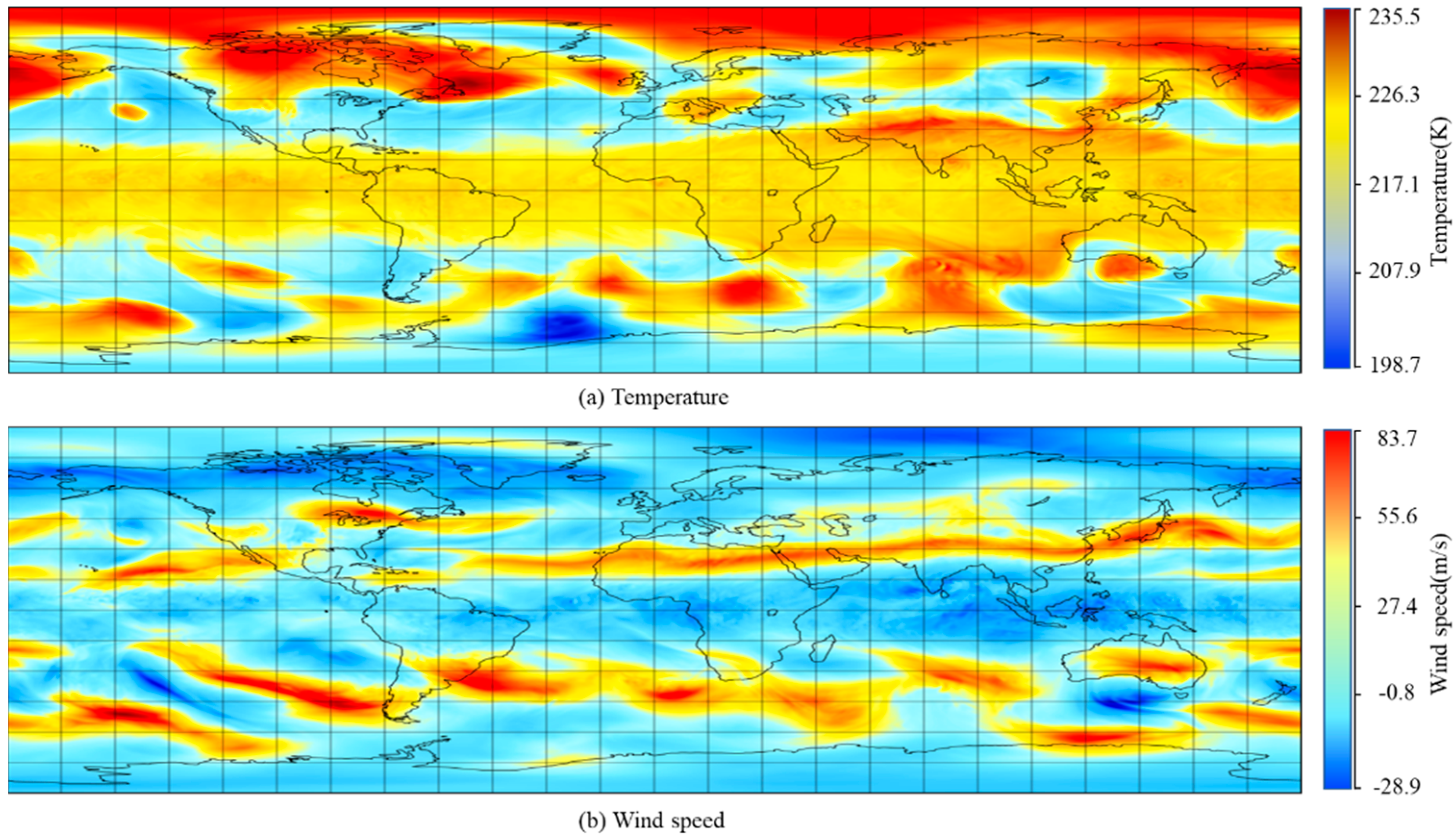
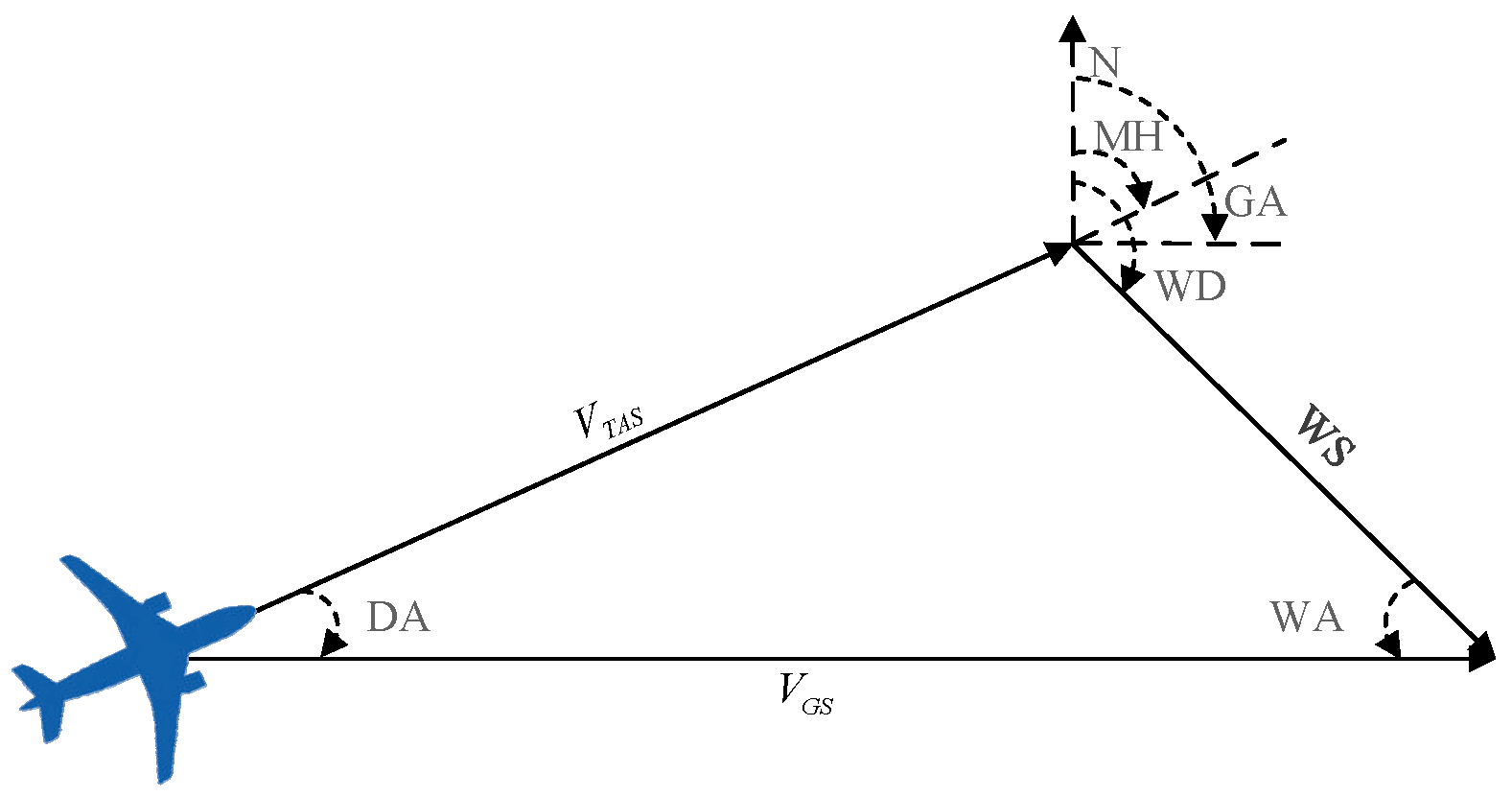


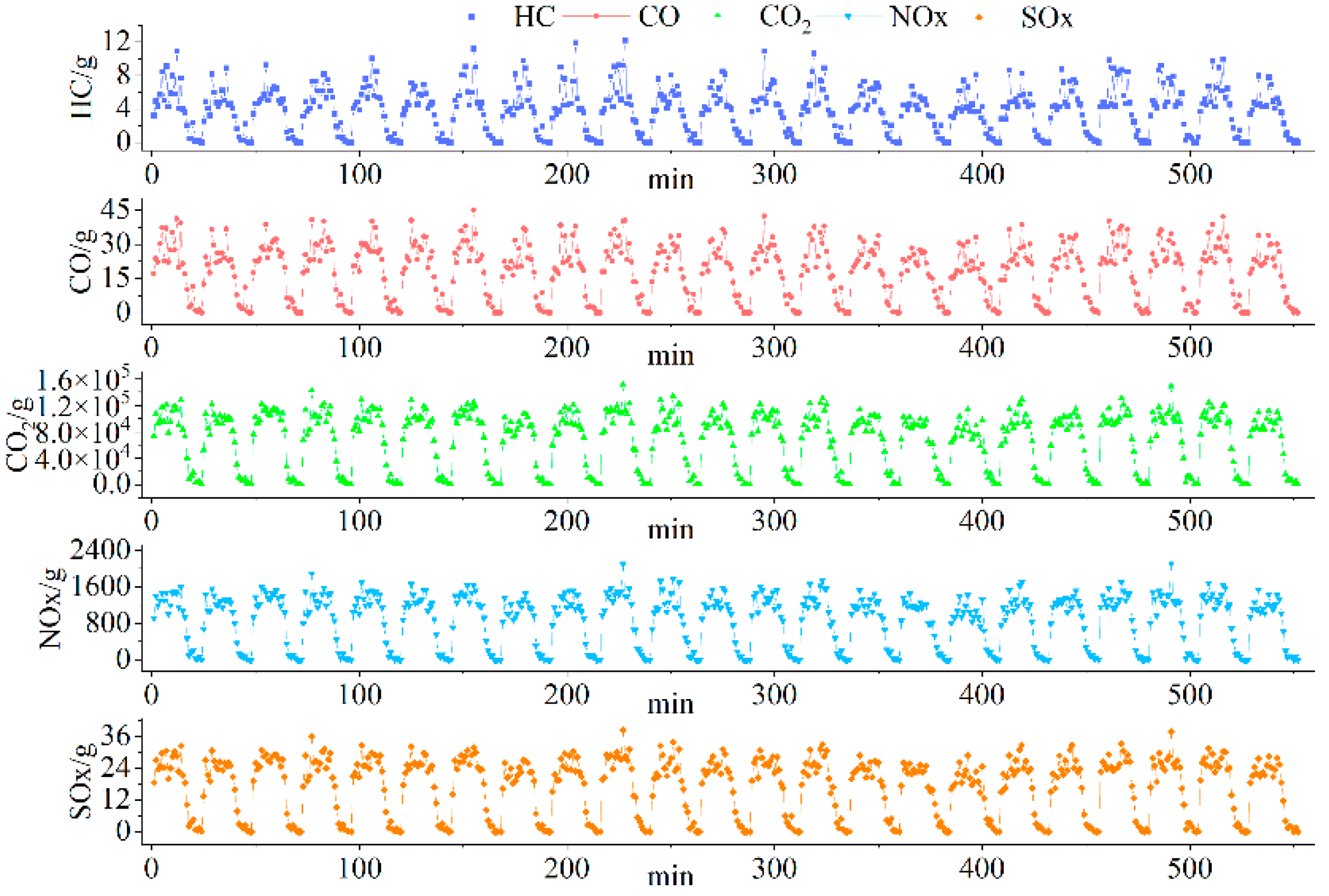

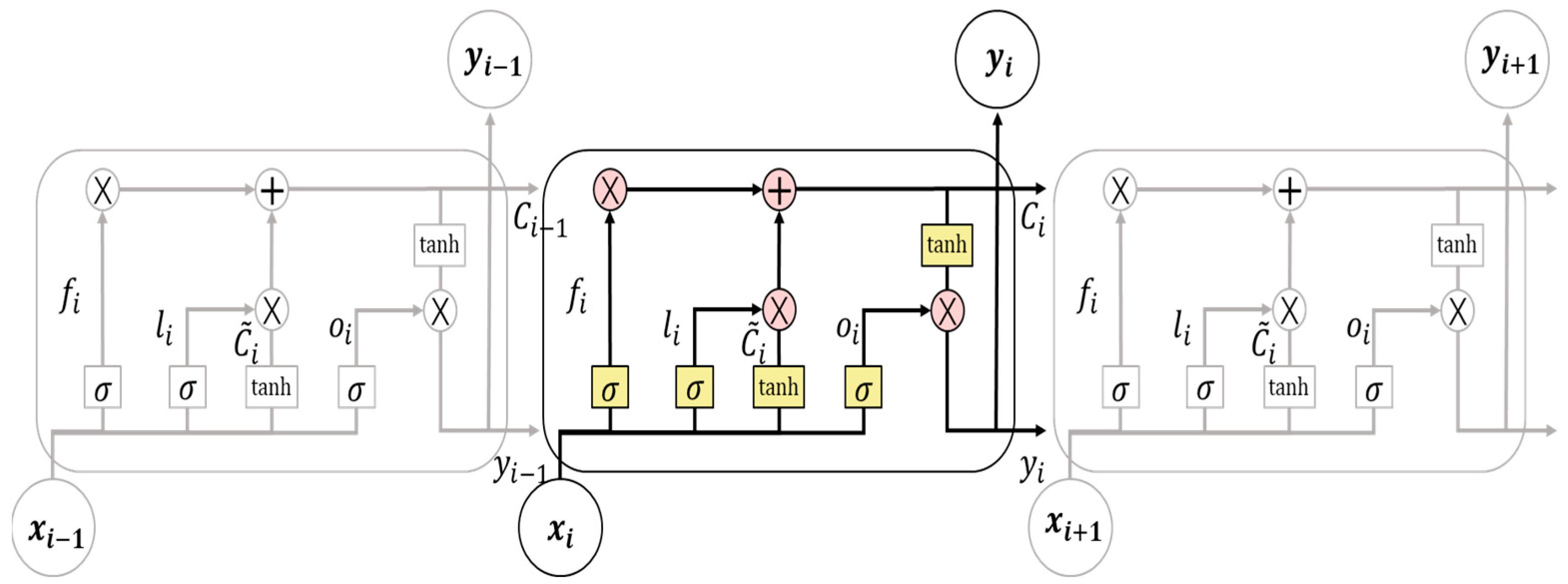

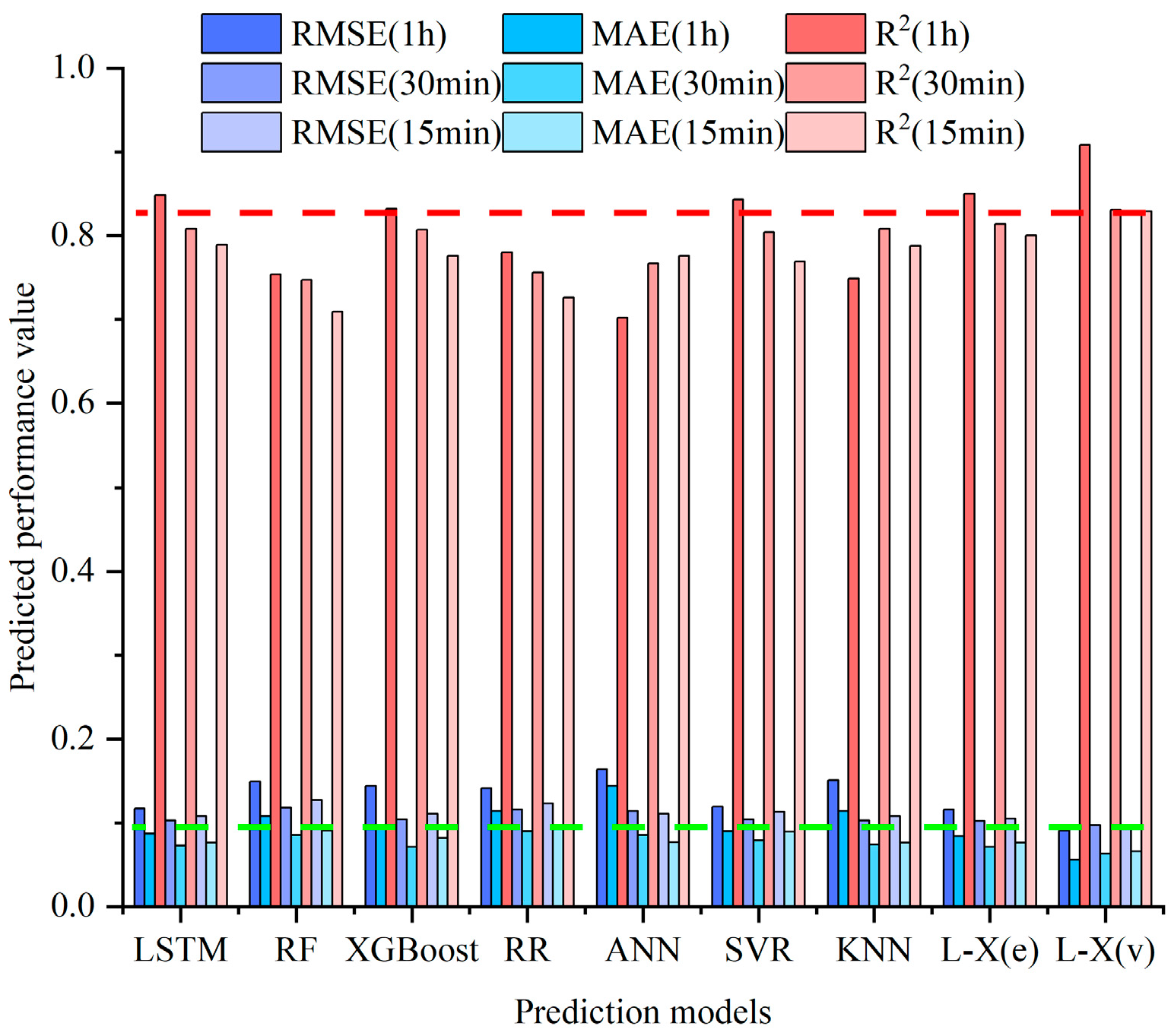
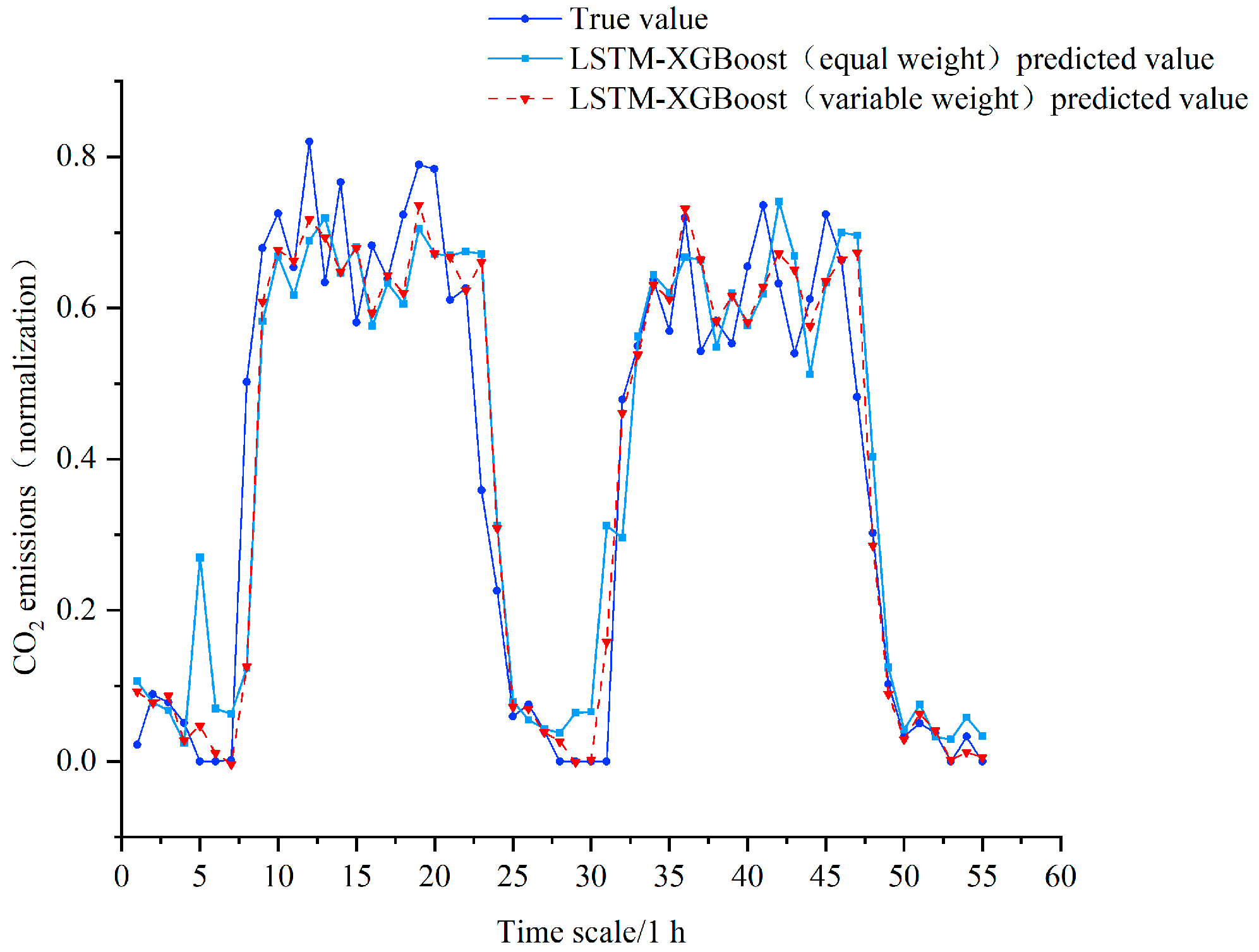
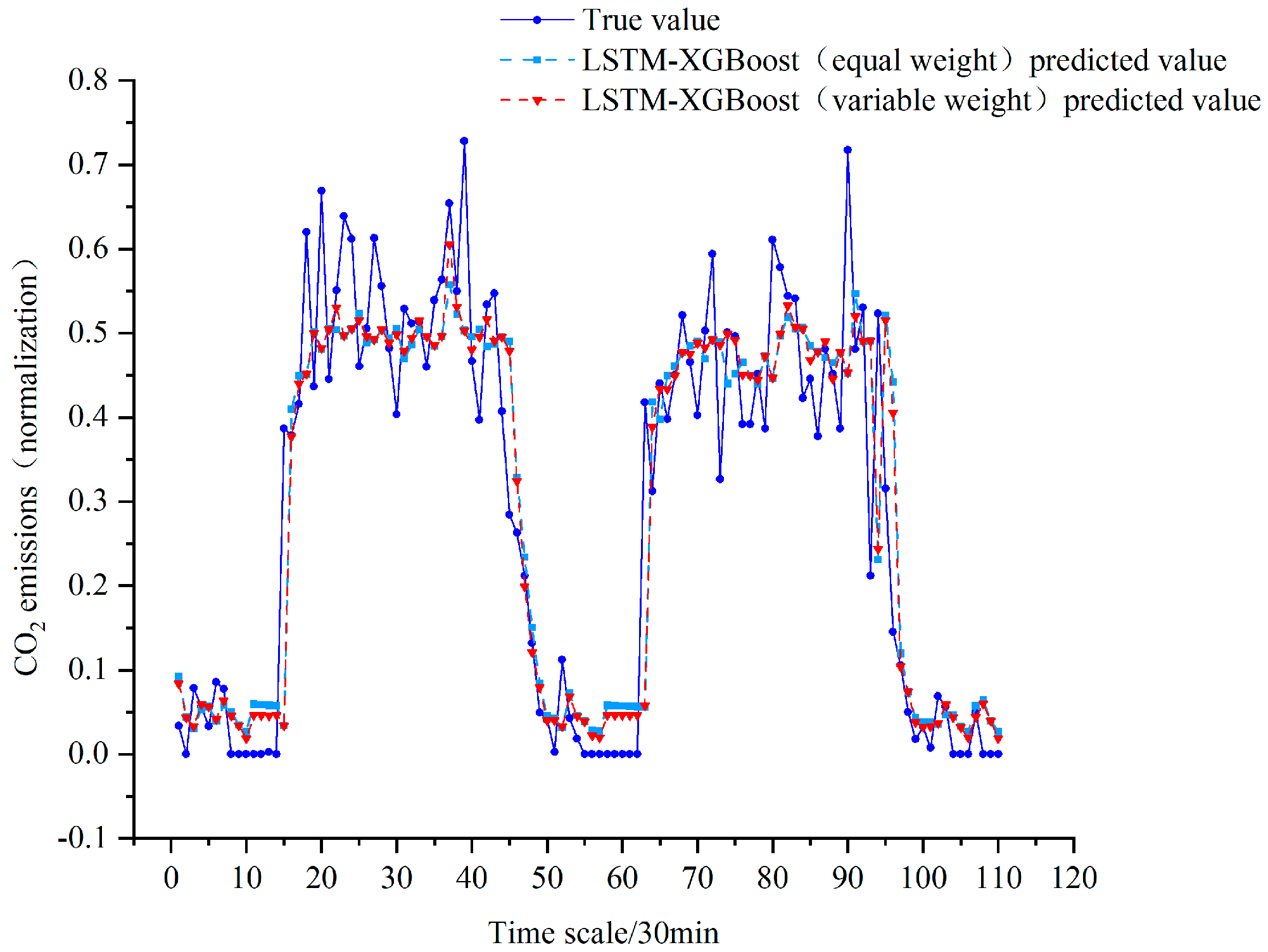

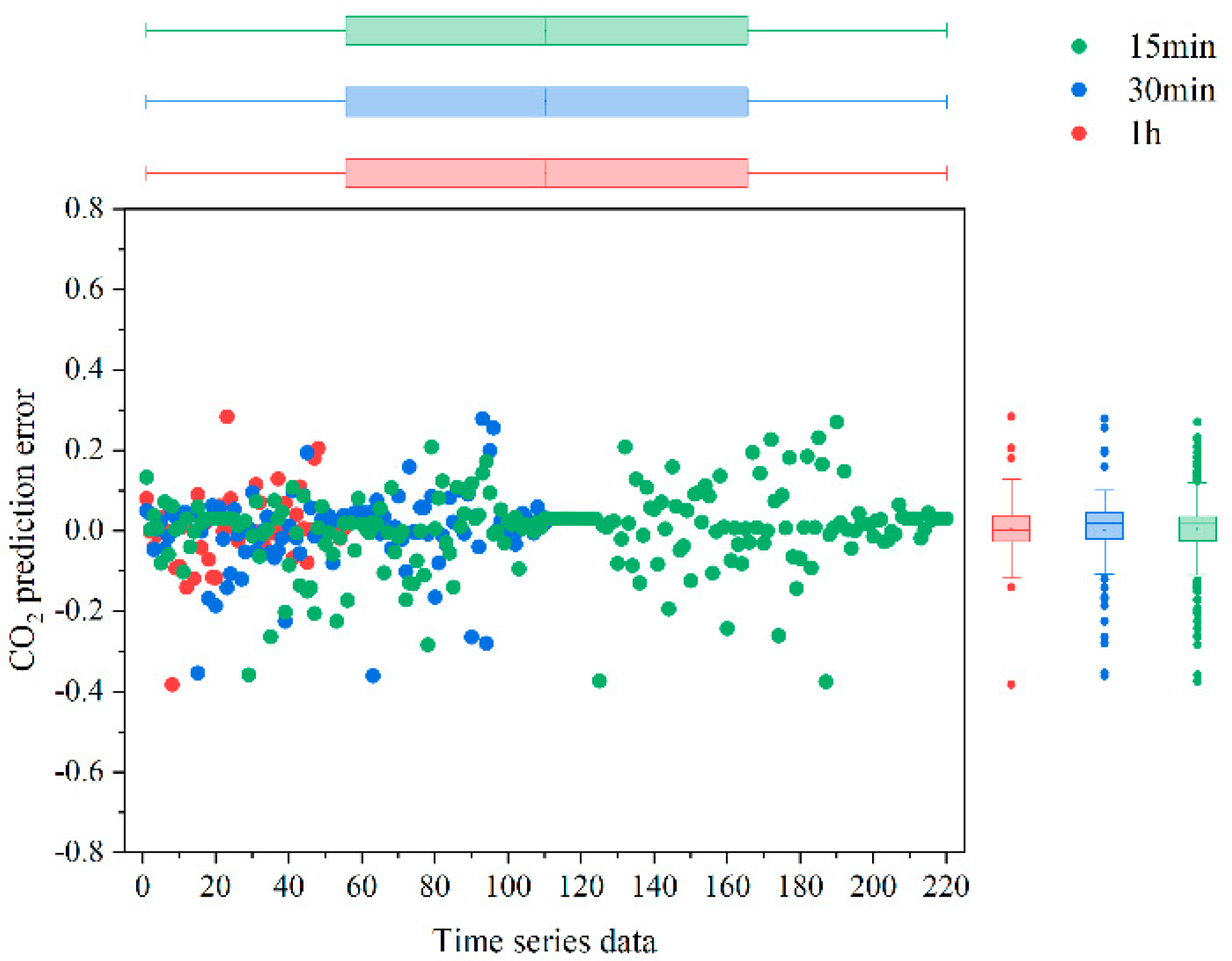


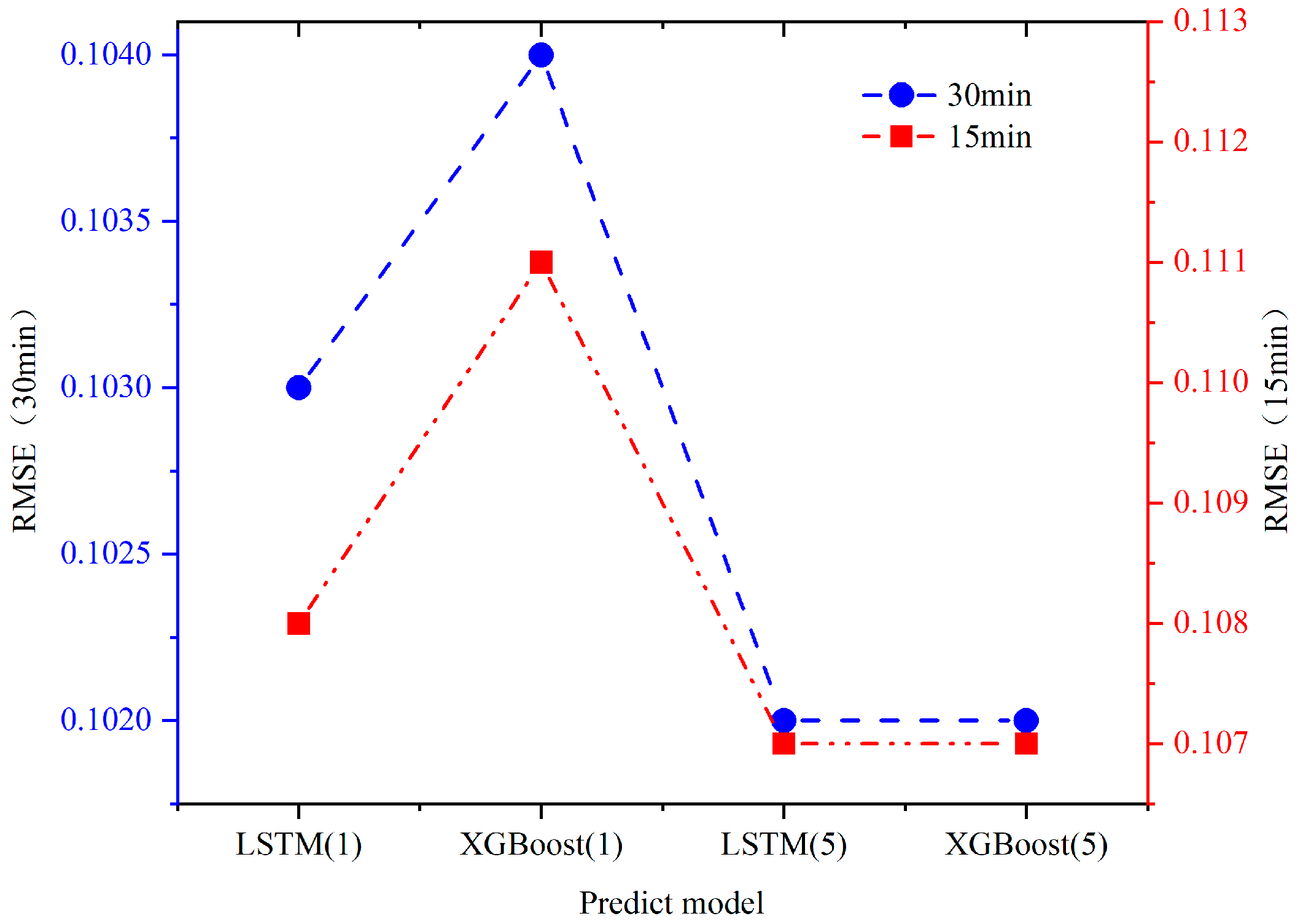


| Callsign | Height | Speed | Longitude | Latitude | … | Time |
|---|---|---|---|---|---|---|
| JT2743 | 11,308.08 | 772.97 | 113.67 | 23.53 | … | 14:07:59 |
| JT2743 | 11,308.08 | 771.38 | 113.66 | 23.55 | … | 14:08:00 |
| JT2743 | 11,308.08 | 770.04 | 113.65 | 23.57 | … | 14:08:01 |
| … | … | … | … | … | … | … |
| JT2743 | 11,308.08 | 767.26 | 113.64 | 23.61 | … | 14:08:23 |
| JT2743 | 11,308.08 | 764.61 | 113.64 | 23.61 | … | 14:08:24 |
| JT2743 | 11,308.08 | 762.59 | 113.63 | 23.64 | … | 14:08:25 |
| Mode of the LTO Cycle | Fuel Flow Rate (kg/s) | Reference Emissions Indices (g/kg) | ||
|---|---|---|---|---|
| REIHC | REICO | REINOx | ||
| Take off | 1.221 | 0.1 | 0.2 | 28.8 |
| Climb | 0.999 | 0.1 | 0.6 | 22.5 |
| Approach | 0.338 | 0.1 | 1.6 | 10.8 |
| Taxi | 0.113 | 1.9 | 18.8 | 4.7 |
| Prediction Models | 1 h | 30 min | 15 min | ||||||
|---|---|---|---|---|---|---|---|---|---|
| RMSE | MAE | R2 | RMSE | MAE | R2 | RMSE | MAE | R2 | |
| LSTM | 0.117 | 0.087 | 0.848 | 0.103 | 0.073 | 0.808 | 0.108 | 0.076 | 0.789 |
| XGBoost | 0.144 | 0.092 | 0.832 | 0.104 | 0.074 | 0.807 | 0.111 | 0.082 | 0.776 |
| RF | 0.149 | 0.108 | 0.754 | 0.118 | 0.085 | 0.747 | 0.127 | 0.091 | 0.709 |
| RR | 0.141 | 0.114 | 0.78 | 0.116 | 0.09 | 0.756 | 0.123 | 0.094 | 0.726 |
| ANN | 0.164 | 0.144 | 0.702 | 0.114 | 0.085 | 0.767 | 0.111 | 0.077 | 0.776 |
| SVR | 0.119 | 0.090 | 0.843 | 0.104 | 0.079 | 0.804 | 0.113 | 0.089 | 0.769 |
| KNN | 0.151 | 0.114 | 0.749 | 0.103 | 0.074 | 0.808 | 0.108 | 0.076 | 0.788 |
| LSTM-XGBoost (equal weight) | 0.116 | 0.084 | 0.850 | 0.102 | 0.071 | 0.814 | 0.105 | 0.076 | 0.800 |
| LSTM-XGBoos (variable weight) | 0.091 | 0.056 | 0.908 | 0.097 | 0.063 | 0.831 | 0.097 | 0.066 | 0.829 |
| Data Sets | Comparative Mode | 30 min | 15 min | ||||
|---|---|---|---|---|---|---|---|
| RMSE | MAE | R2 | RMSE | MAE | R2 | ||
| Excluding other emissions | LSTM (1) | 0.103 | 0.073 | 0.808 | 0.108 | 0.076 | 0.789 |
| XGBoost (1) | 0.104 | 0.074 | 0.807 | 0.111 | 0.082 | 0.776 | |
| Including other emissions | LSTM (5) | 0.102 | 0.072 | 0.812 | 0.107 | 0.075 | 0.792 |
| XGBoost (5) | 0.102 | 0.070 | 0.814 | 0.107 | 0.075 | 0.795 | |
Publisher’s Note: MDPI stays neutral with regard to jurisdictional claims in published maps and institutional affiliations. |
© 2022 by the authors. Licensee MDPI, Basel, Switzerland. This article is an open access article distributed under the terms and conditions of the Creative Commons Attribution (CC BY) license (https://creativecommons.org/licenses/by/4.0/).
Share and Cite
Wan, J.; Zhang, H.; Lyu, W.; Zhou, J. A Novel Combined Model for Short-Term Emission Prediction of Airspace Flights Based on Machine Learning: A Case Study of China. Sustainability 2022, 14, 4017. https://doi.org/10.3390/su14074017
Wan J, Zhang H, Lyu W, Zhou J. A Novel Combined Model for Short-Term Emission Prediction of Airspace Flights Based on Machine Learning: A Case Study of China. Sustainability. 2022; 14(7):4017. https://doi.org/10.3390/su14074017
Chicago/Turabian StyleWan, Junqiang, Honghai Zhang, Wenying Lyu, and Jinlun Zhou. 2022. "A Novel Combined Model for Short-Term Emission Prediction of Airspace Flights Based on Machine Learning: A Case Study of China" Sustainability 14, no. 7: 4017. https://doi.org/10.3390/su14074017
APA StyleWan, J., Zhang, H., Lyu, W., & Zhou, J. (2022). A Novel Combined Model for Short-Term Emission Prediction of Airspace Flights Based on Machine Learning: A Case Study of China. Sustainability, 14(7), 4017. https://doi.org/10.3390/su14074017







